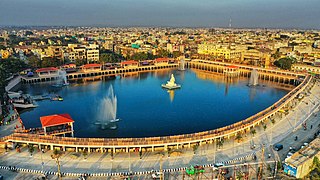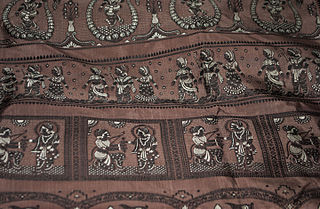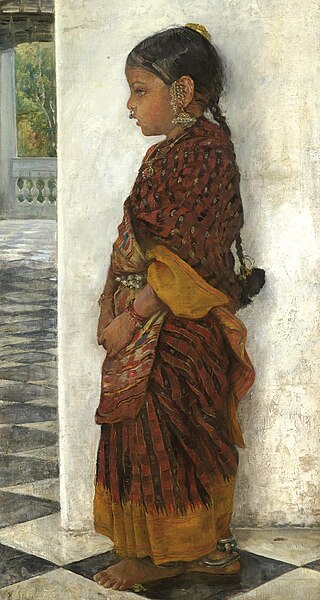Related Research Articles

Brahmapur is a city on the eastern coastline of Odisha, India.

Mysore Silk is variety of mulberry silk produced in the Indian district of Mysore, Karnataka.

Paithani is a variety of sari, named after the Paithan town in Aurangabad district from state of Maharashtra in India where the sari was first made by hand. Present day Yeola town in Nashik, Maharashtra is the largest manufacturer of Paithani.
Ilkal is a City in Bagalkot district in the Indian state of Karnataka. The town is located in a valley that lies in south-east corner of Bagalkot district and is quite close to the borders of Kushtagi taluk of the Koppal district. Now Ilkal city becomes taluk previous the city falls within the jurisdiction of Hungund taluk and lies at a distance of about 12 km (7.5 mi) south of taluk headquarters. Between these two towns, Ilkal is an important centre of trade, commerce, education, and industry. Ilkal is well connected with state and national highways. It is also famous for its hospitality and education institutions.

Silk In India, about 97% of the raw mulberry silk is produced in the Indian states of Karnataka, Andhra Pradesh, Tamil Nadu and West Bengal. Mysore and North Bangalore, the upcoming site of a US$20 million "Silk City", contribute to a majority of silk production. Another emerging silk producer is Tamil Nadu in the place in where mulberry cultivation is concentrated in Salem, Erode and Dharmapuri districts. Hyderabad, Andhra Pradesh and Gobichettipalayam, Tamil Nadu were the first locations to have automated silk reeling units.
Assam silk denotes the three major types of indigenous wild silks produced in Assam—golden muga, white pat and warm eri silk. The Assam silk industry, now centered in Sualkuchi, is a labor-intensive industry.

Kanchivaram is a 2008 Indian Tamil-language period drama film written and directed by Priyadarshan. The film stars Prakash Raj and Shriya Reddy and has music by M. G. Sreekumar, cinematography by Tirru, editing by Arun Kumar, and art direction by Sabu Cyril. The audiography was done by M. R. Rajakrishnan. The movie depicts the pitiable state of the silk weavers in the town of Kanchipuram as they were unorganized and marginalized to live a perpetual ‘hand-to-mouth’ existence. The movie depicts their struggles and ends with a comment about the cooperative movement that emerged to take care of the interests of the workers.

A Sambalpuri sari is a traditional handwoven bandha (ikat) sari wherein the warp and the weft are tie-dyed before weaving. It is produced in the Sambalpur, Balangir, Bargarh, Boudh and Sonepur districts of Odisha, India. The sari is a traditional female garment in the Indian subcontinent consisting of a strip of unstitched cloth ranging from four to nine meters in length that is draped over the body in various styles.
The textile industry in Salem, especially the handloom industry, is one of the most ancient cottage industries in Salem district of Tamil Nadu, India. Salem was one of the primary handloom centers of south India. Sari, dhoti and angavasthram are made out of silk yarn and cotton yarn. In the recent past, home furnishing items are also woven, mainly for export purposes. More than 75,000 handlooms are working and the total value of cloth produced per annum is estimated at Rs.5,000 crores

The Kanchipuram silk sari is a type of silk sari made in the Kanchipuram region in Tamil Nadu, India. These saris are worn as bridal & special occasion saris by most women in Tamil Nadu, Kerala, Karnataka & Andhra Pradesh. It has been recognized as a Geographical indication by the Government of India in 2005–2006.

Baluchari Sari is a type of sari, a garment worn by women in the Indian states of West Bengal, Tripura and Assam and the country of Bangladesh. This particular type of sari originated in West Bengal and is known for depictions of mythological scenes on the anchal of the sari. It used to be produced in Murshidabad but presently Bishnupur and its surrounding areas of West Bengal are the only place where authentic Baluchari saris are produced. It takes approximately one week to produce one such sari. In 2011, the Baluchari Sari was granted the status of Geographical Indication for West Bengal in India.

Brahmapur is a major and one of the oldest railway stations in the Indian state of Odisha. Brahmapur well known as “The Silk City", is a city on the eastern coastline of the state of Odisha. Brahmapur Railway Station is one of the oldest Railway Station and it is administered under Khurda Road railway division of East Coast Railway zone. This station is classified as Non-Suburban Grade-3 (NSG-3) Category Station earlier categorized as ‘A’ category station. An average foot fall of 12,000 nos. are dealt here on daily basis. It is one of the major hub for Education & Business and railway provide hassle-free connectivity to this place. Brahmapur is famous for its tourist attraction. Tara Tarini an ancient Shakti peetha, Breast shrine of Adi Shakti and one amongst the 4 major Shakti Peeethas in India is 25 km from the city. In addition, the world famous Gopalpur-on-Sea sea beach, Bhairabi & MahuriKalia temples, and Tampara lake are around 10km from the city. The famous Chilika Lake at Rambha and Taptapani Hot Springs are around 45 km from the city. It is silk city so silk products are cheap and readily available. This place is also famous for a variety of pickles, mixtures and papad.
Bhagalpur sari is an silk sari made in Bhagalpur, India. More than a century old, Tussar silk weaving industry in Bhagalpur has about 30,000 handloom weavers working on some 25,000 handlooms. The total value of annual trade is around Rs. 100 crores, about half of which comes from exports.

Pochampally sari or Pochampalli ikat is a saree made in Bhoodan Pochampally, Yadadri Bhuvanagiri district, Telangana State, India. They have traditional geometric patterns in "Paagadu Bandhu" (Ikat) style of dyeing. The intricate geometric designs find their way into sarees and dress materials. The Indian government's official airplane company, Air India, has its cabin crew wear specially designed Pochampally silk sarees.

Kukudakhandi popularly known as KKD is one of the significant villages in the Kukudakhandi Tehsil of Ganjam district in the Indian State of Odisha. The village is 31.2 km from its district main sub-division Chatrapur and is 149 km from its State capital Bhubaneswar. KKD is more often considered as a part of the city Berhampur
Kovai Cora cotton or Kovai Kora cotton is a type of cotton saree made in the Coimbatore region in Tamil Nadu, India. It has been recognized as a Geographical indication by the Government of India in 2014–15.

Handloom saris are a traditional textile art of Bangladesh and India. The production of handloom saris is important for economic development in rural India.

Habaspuri is a cotton-based traditional handloom textiles of Odisha, India. Habaspuri sari is a major product of this textile. The Bhulia weavers of Chicheguda, Kalahandi district, Odisha are originally attributed for weaving of the Habaspuri fabric. For its uniqueness in weaving, design and production, it has been identified as one of the 14 Geographical Indications of Odisha.

Odisha Ikat, is a kind of ikat known as Bandhakala and Bandha, a resist dyeing technique, originating from Indian state of Odisha. Traditionally known as "Bandhakala"', "Bandha", '"Bandha of Odisha", it is a geographically tagged product of Odisha since 2007. It is made through a process of tie-dyeing the warp and weft threads to create the design on the loom prior to weaving. It is unlike any other ikat woven in the rest of the country because of its design process, which has been called "poetry on the loom". This design is in vogue only at the western and eastern regions of Odisha; similar designs are produced by community groups called the Bhulia, Kostha Asani, and Patara. The fabric gives a striking curvilinear appearance. Saris made out of this fabric feature bands of brocade in the borders and also at the ends, called anchal or pallu. Its forms are purposefully feathered, giving the edges a "hazy and fragile" appearance. There are different kinds of bandha saris made in Odisha, notably Khandua, Sambalpuri, Pasapali, Kataki and Manibandhi.
Kotpad Handloom is a vegetable-dyed fabric woven by the tribal weavers of the Mirgan community of Kotpad village in Koraput district, Odisha, India. Cotton sarees with solid border and Pata Anchal, duppatta with typical Buties / motifs, Scolrfs on cotton, silk, handloom stoles, and dress materials are all dyed with organic dyes. The natural dye is manufactured from the aul tree grown in this area. The Kotpad tussar silk saree with tribal art and Kotpad handloom fabrics with natural color is its specialty.
References
- ↑ "Silk". Beauty Without Cruelty - India. Retrieved 30 January 2016.
- ↑ mahanty, hrushikesh. "Berhampur charts silk route to recognition". Times Of India. Times of India. Retrieved 30 January 2016.
- ↑ odisha news, fullodisha.com. "Now you can Buy Berhampuri Patta Online". fullodisha.com. Archived from the original on 21 January 2016. Retrieved 30 January 2016.
- ↑ "ବୁଣାକାରଙ୍କ ଲାଗି ୱେବସାଇଟ୍ ଉନ୍ମୋଚିତ - ଏଣିକି ଅନଲାଇନରେ ମିଳିବ ବୁଣାକାରଙ୍କ ପାଟ" . Retrieved 30 January 2016.
